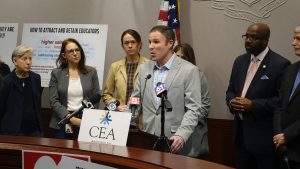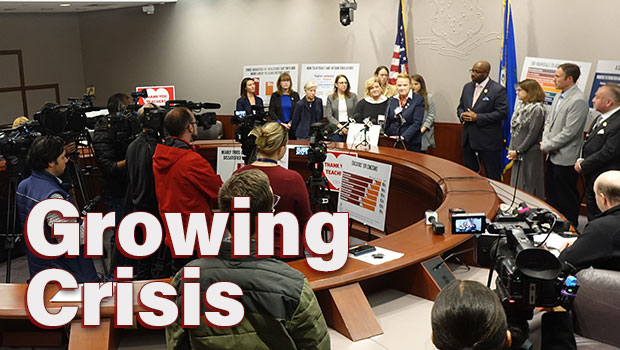A growing crisis in Connecticut’s public schools brought CEA leaders and elected officials together to focus on solutions ahead of the 2023 legislative session.
“Three-quarters of our teaching workforce is looking to do something else,” CEA President Kate Dias told reporters at a morning news conference at the Legislative Office Building. “I don’t know how much more of a siren we need to wail to get a sense of urgency around this issue. We cannot wait until a hundred percent of our educators are looking to leave before we decide to act.”
Dias was referring to results of a new CEA survey in which 74% of educators reported they are more likely now, compared to a few years ago, to exit the profession. That’s up from 55% of teachers surveyed by the National Education Association in January and 38% of teachers surveyed by CEA last fall.
Behind the spike are escalating teacher stress and burnout, an unaddressed educator shortage that continues to swell class sizes and multiply educators’ workload, pay that has not kept up with the demands of the profession, and numerous other issues.
“We cannot get our jobs done,” Dias said. “We have been set up to fail.”
Noting several hundred unfilled positions in special education alone at the beginning of the school year, combined with factors such as additional paperwork and an hourlong IEP process that now takes ten hours, she said, “It’s safe to say that every single special education teacher we have in the state of Connecticut is doing double duty right now.”
Dias also pointed to attempts at bringing back the banned practice of dual instruction, efforts to upend reading and writing programs in schools, and more.
Top issues
Nearly all educators surveyed (98%) identified teacher stress and burnout as their top issue, 96% acknowledged staff shortages, and 93% identified the lack of respect for teachers and students’ mental health needs.

Representative-elect Kevin Brown, a high school teacher, describes the challenges he and his colleagues face.
“Stress and burnout looks like teachers who are teaching more than 28 students in a classroom,” said Dias. “Stress and burnout looks like a high school teacher having to teach seven sections of math instead of five. Stress and burnout looks like excessive paperwork and unnecessary mandates that create pressure outside the classroom that take teachers’ attention away from the important work of serving children.”
Furthermore, teachers’ salaries have not kept pace with those of professions requiring similar advanced degrees and responsibilities—so much so that educators often cannot afford to reside in or near the districts where they teach.
“That’s a real statement,” said Dias. “We value you, but please don’t live here.”
She added, “These are problems that can be solved. If you know a teacher, then you know somebody who has a solution to the shortage problem. If you know a teacher, you know somebody with immediate ideas. But you’ve got to listen to them.”
Education allies
Joining CEA at the news conference and in the push to address the crisis were Representative-elect Kevin Brown—himself a CEA member—along with Representatives Kate Farrar, Jillian Gilchrest, Kathleen Kennedy, Jennifer Leeper, Kathleen McCarty, Anthony Nolan, and Mary Welander. All legislators emphasized the immediate need for meaningful change and strong investments in the teaching profession.
“This is an emergency situation, and we have to treat it as such,” said Brown, a CREC high school civics teacher who has felt the full effects of larger class sizes and fewer resources. “This is not a sustainable model. We need to treat teachers with the professionalism that they come to their jobs with. This is a highly educated workforce with certification and advanced degrees we typically reserve for higher-paying jobs in private industry, but that’s who’s going into your children’s classrooms every day.”

Representative Kathleen McCarty calls on fellow legislators to address the crisis facing the teaching profession and Connecticut schools.
“I’m the daughter of two public school teachers,” said Rep. Gilchrest. “I saw firsthand my parents’ passion and commitment to this profession, and I second what CEA has said—that we need to listen to the voices of our public school teachers here in Connecticut. They are crying out for help.” The mother of two public school students as well, Gilchrest added, “We need to give our public school teachers the respect they deserve, which means listening to them, paying them what they are worth, and giving them the space and time they need to prepare for their classes. I look forward to working with my colleagues on bipartisan efforts to improve conditions for our teachers.”
“It’s very important that we look at teacher retention and recruitment and that we help our teachers stay in the classroom and bring back the joy of teaching,” said Rep. McCarty, a ranking member of the legislature’s Education Committee. “Our teachers have had to go through so much during this pandemic; the demands that we have placed on them are monumental.” McCarty called on all of her colleagues to work collaboratively with educators and in a bipartisan manner. “It’s time that we show our teachers that we respect them and that we’re going to uplift the profession and make education a joyful, creative experience for teachers and students.”
According to CEA’s survey, teachers’ priorities to strengthen and diversify the profession include
- Salaries commensurate with comparable professions
- Pandemic pension credit
- Streamlined teacher evaluation
- Reduced standardized test burden
- Increased opportunities for play-based learning and creativity
See the complete survey results.
Watch the news conference.
Read the news release.
View media coverage.







